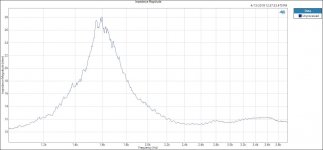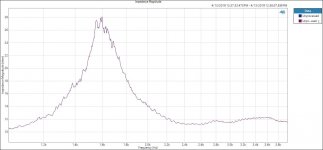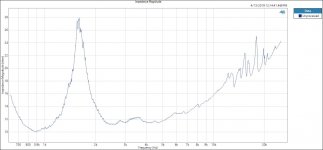Hello,
Here is another CD/ waveguide combination.
JBL2451J / JBL PT1010HF-1
The first plot is the first impedance plot of the JBL2451J / JBL PT1010HF-1 CD/Waveguide.
The second attached plot is the first sweep (note the time stamp) with a second sweep appended right on top of the first. The saw teeth are in the exact same positions on the graph.
The third attached plot is the same CD/waveguide with wider band width. Compare the saw teeth on this plot with the other two.
Thanks DT
Here is another CD/ waveguide combination.
JBL2451J / JBL PT1010HF-1
The first plot is the first impedance plot of the JBL2451J / JBL PT1010HF-1 CD/Waveguide.
The second attached plot is the first sweep (note the time stamp) with a second sweep appended right on top of the first. The saw teeth are in the exact same positions on the graph.
The third attached plot is the same CD/waveguide with wider band width. Compare the saw teeth on this plot with the other two.
Thanks DT
Attachments
Hello,
Here is another CD/ waveguide combination.
JBL2451J / JBL PT1010HF-1
The first plot is the first impedance plot of the JBL2451J / JBL PT1010HF-1 CD/Waveguide.
The second attached plot is the first sweep (note the time stamp) with a second sweep appended right on top of the first. The saw teeth are in the exact same positions on the graph.
The third attached plot is the same CD/waveguide with wider band width. Compare the saw teeth on this plot with the other two.
Thanks DT
The peaks are a mere 10-15 Hz apart. Is the building shaking?
Hello gedlee and All,
We all like the smooth curves on sales brochures.
When it comes down to it I can show you the raw data or I can turn on all the averaging, curve fitting and smoothing functions in the software.
We do the same with same with frequency response data.
Backing up a step I do believe that we share the concept that CD’s / Horns / Waveguides are not the smoothest of devices and that a little damping may help a bit.
I have sent $100.00 by PayPal to your email address for a block of the real 30ppi foam.
I will post my measurements here.
Thanks DT
We all like the smooth curves on sales brochures.
When it comes down to it I can show you the raw data or I can turn on all the averaging, curve fitting and smoothing functions in the software.
We do the same with same with frequency response data.
Backing up a step I do believe that we share the concept that CD’s / Horns / Waveguides are not the smoothest of devices and that a little damping may help a bit.
I have sent $100.00 by PayPal to your email address for a block of the real 30ppi foam.
I will post my measurements here.
Thanks DT
There is an optimum smoothing that is based on the resolution of the ear. By using Moore or Zwicker's Critical Band Theory (CB) a smoothing that mimics the human ear can be created. Some smoothing makes a lot of sense because no measurement is without noise, which a lot of the sharp peaks and dips are. FYI they are about 1/20 octave at HFs going down to about 1/3 octave at LFs - but not linearly.
Hello gedlee,
I like the idea of smoothing Frequency Response plots to match human hearing or the sensitivity of the Basilar Membrane. Your eye will see what your ear will hear.
In terms noise I am not so sure that the peaks and dips on the raw impedance plots are noise. The peaks and dips are not random. They are recurring at the same frequencies and magnitude on subsequent plots. I have seen buildings shake due large rotational equipment; fans and compressors. I have seen ripples in the water pitcher on the conference room table.
Prior to software smoothing I am going to try a little damping with Dacron pillow stuffing, wool and 30ppi foam first.
Thanks DT
I like the idea of smoothing Frequency Response plots to match human hearing or the sensitivity of the Basilar Membrane. Your eye will see what your ear will hear.
In terms noise I am not so sure that the peaks and dips on the raw impedance plots are noise. The peaks and dips are not random. They are recurring at the same frequencies and magnitude on subsequent plots. I have seen buildings shake due large rotational equipment; fans and compressors. I have seen ripples in the water pitcher on the conference room table.
Prior to software smoothing I am going to try a little damping with Dacron pillow stuffing, wool and 30ppi foam first.
Thanks DT
Hello All,
I am away from the bench for a few days.
I am wondering what electronic damping will do to a CD/horn / waveguide. For example the D2 CD in the JBL M2 speaker has a series pair of capacitors (8uF total) an 11 Ohm resistor in series and a 13 Ohm resistor in parallel with the D2 driver. In addition to padding the D2 driver the overall impedance curve is much flatter.
I will include the above driver attached to the PT HF1010 -1 JBL waveguide in my acoustic tests.
I will not be listening but will be wearing hearing protection for the 30 ppi foam FR and impedance testing.
Listening comes later.
Thanks DT
Also I ordered a copy of https://www.amazon.com/dp/9004252428?psc=1&ref=ppx_yo2_dt_b_product_details
to read about the ear and critical band.
I am away from the bench for a few days.
I am wondering what electronic damping will do to a CD/horn / waveguide. For example the D2 CD in the JBL M2 speaker has a series pair of capacitors (8uF total) an 11 Ohm resistor in series and a 13 Ohm resistor in parallel with the D2 driver. In addition to padding the D2 driver the overall impedance curve is much flatter.
I will include the above driver attached to the PT HF1010 -1 JBL waveguide in my acoustic tests.
I will not be listening but will be wearing hearing protection for the 30 ppi foam FR and impedance testing.
Listening comes later.
Thanks DT
Also I ordered a copy of https://www.amazon.com/dp/9004252428?psc=1&ref=ppx_yo2_dt_b_product_details
to read about the ear and critical band.
While I’m waiting for my foam I’ve been contemplating what to do with the unused portion as I only have one set of small horns.
I wonder if filling port vents(loosely of course) with 30 ppi would turn the box into aperiodic?
Say I have a 10” mid/bass driver in a 2 cubic foot box, each box has two round vents 2” wide x 5” length, if it would work how much foam would be a good starting point? 30%,50%,100% ?
Just for subjective testing,no design goals at this time.
I ask because if it’s not going to work in that capacity I’d rather save the leftovers intact.
I wonder if filling port vents(loosely of course) with 30 ppi would turn the box into aperiodic?
Say I have a 10” mid/bass driver in a 2 cubic foot box, each box has two round vents 2” wide x 5” length, if it would work how much foam would be a good starting point? 30%,50%,100% ?
Just for subjective testing,no design goals at this time.
I ask because if it’s not going to work in that capacity I’d rather save the leftovers intact.
Last edited:
Remember that the flow resistance of 30 ppi is very low. Hence its effects weaken with frequency, in general, there are probably peaks and dips due to resonances in the material structure. It would be almost vanishingly low resistant at VLF.
I've tried it in vents, thought it was different, not a large effect. But it can detune a system from ideal response, so that's a complication.
I've tried it in vents, thought it was different, not a large effect. But it can detune a system from ideal response, so that's a complication.
Thanks DT, the speakers I’m wanting to try the foam in ports on have a sweet spot (at least in my room) with very loose fiber fill in the whole port, I was looking for a more precise/permanent way to do it maybe the nylon stockings would do it! I may order up some finer reticulated foam to try……these are some Franken-speakers that I’ve played with over the years for testing (started life as Burhoe blues) they are crossed to subs @ 60hz and the 10”pro driver I’m using has a fs of 50hz……box is tuned for F3 @ 44hz, and yes I know it should be above FS but after a long trial and error period this was the best compromise……..the area I’m trying to tune is so fine I’ll need to be precise that’s why I thought foam might be the answer. I don’t want to veer off topic, just thought I’d fill in the what/why.
Hello All,
I have been away a couple of weeks or so.
Inside my door where my cat sitter left it is a medium large box containing acoustic foam the real deal.
I am thinking of it as damping for the mouth and throat of a horn. The fewer reflections inside the throat of the horn the less damping.
The fewer the reflections the less the thing sounds like a horn.
We will see.
Thanks DT
I have been away a couple of weeks or so.
Inside my door where my cat sitter left it is a medium large box containing acoustic foam the real deal.
I am thinking of it as damping for the mouth and throat of a horn. The fewer reflections inside the throat of the horn the less damping.
The fewer the reflections the less the thing sounds like a horn.
We will see.
Thanks DT
Hi. Have you made any progress on the foam plug application?Hello All,
I have been away a couple of weeks or so.
Inside my door where my cat sitter left it is a medium large box containing acoustic foam the real deal.
I am thinking of it as damping for the mouth and throat of a horn. The fewer reflections inside the throat of the horn the less damping.
The fewer the reflections the less the thing sounds like a horn.
We will see.
Thanks DT
- Home
- Loudspeakers
- Multi-Way
- Question for Dr. Geddes about his WG foam plug


